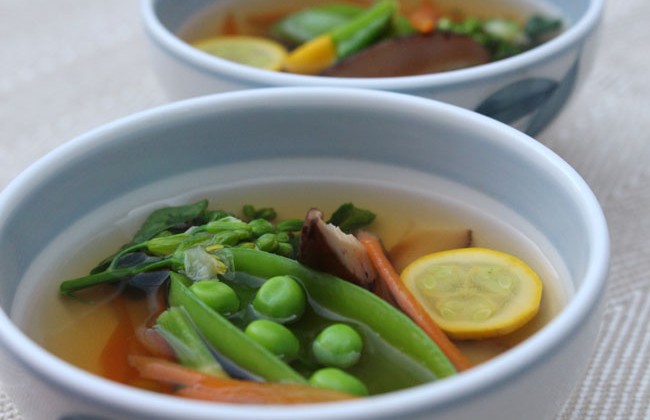Our bodies are more than 50% water. You’ve probably heard that, right?
According to chemistry expert Anne Marie Helmenstine, Ph.D., the amount of water in the human body ranges from 50–75%. The average adult human body is 50–65% water, averaging around 57–60%. The percentage of water in infants is much higher, typically around 75–78% water, dropping to 65% by 1 year of age.*

Daikon radish is one of my favorite vegetable for making soup.
When I learned macrobiotic vegan cooking in 1993 to heal from ovarian cancer, I learned to soak whole grains and beans in water (spring or purified) 4–6 hours or overnight before cooking. Soaking helps with digestion and makes whole grains and beans softer, with more liquid content.
I realized that our bodies need more nourishing foods like soup, which has more liquid, every day. It does not have to be a large amount—just 1–2 cups a day. Dealing with my cancer taught me this principle, and since then, I have soup every day. Usually, I have one cup of miso soup with three or more kinds of vegetables in the morning; many times, I have a creamy soup at lunchtime and even dinner.

Kombu and shiitake mushroom umami dashi (stock) in the beginning

Kombu and shiitake mushroom umami dashi (stock) after 10 minutes.
Kombu & Shiitake Dashi (this is how you create the Umami flavor)
purified water
kombu, dried (use one 1⁄2-inch square piece per cup of water)
dried shiitake mushrooms (one shiitake for every 1 to 2 cups of water)
- Wipe to clean kombu and shiitake with a dry cloth.
- To make dashi, use one of the following methods:
1) No-cook method: In a bowl, combine the kombu, shiitake and water and soak for at least 2 to 3 hours.
2) Stovetop method: In a saucepan over medium- high flame, combine the kombu and water. Bring to a boil, reduce heat and simmer (either covered or uncovered) for about 20 to 30 minutes. - Strain out and reserve the kombu strip to make Kombu Condiment. Dashi is now ready for use in soups and stews. Dashi will keep for 2 or 3 days in the refrigerator.
Soup helps the digestive system and gives us gentle energy to be able to relax in a natural way. Many busy people come home and eat bread or microwavable food to save time, but bread is dry, and microwavable food provides more chaotic energy. Overall, they cause contracted tightness, and we are unable to relax our intestines, body or mind.
It doesn’t take much time to make soup a few times a week. A large quantity will last few days, and you can easily reheat it on the stove. It is simple if you plan a menu every week.

Miso soup that we made in the class.
When I teach my macrobiotic principle cooking series, the first two classes cover whole grains, and the third is soup. In last week’s class, I taught how to make five different soups using umami dashi:
- Kombu & shiitake dashi (this is how you create the umami flavor)
- Clear soup (consommé)
- Miso soup (summer vegetables)
- Whole grain and vegetable soup (summer whole grain)
- Creamy soup (summer corn soup)

Showing how to cut corn my husband, Chef Eric way.

Showing a half moon cut onion.
My teachings include:
Cut vegetables after you carefully wash them. Keep vegetables separate from one another so they do not exchange their energy before cooking. Add the vegetables one by one, letting them meet slowly and get along together. Once you add the vegetables together, do not mix too much; they do not need a lot of help to create a peaceful and delicious soup. We are just there to support them.

Keep all the vegetables separate till you cook.
When you add seasoning—soy sauce (or tamari, if you need gluten-free), miso or sea salt—do not add too much, so you do not lose the each vegetable’s delicate aroma and texture. Most of the foods we eat are abundant with seasoning (spices, oils), making us unable to taste the vegetable/plant/whole grain itself. I’ll occasionally add more seasoning for certain special foods, but many people add strong spices and oils to most of their food, even with plant-based menus.

Corn cobs for making sweet dashi (stock).

Making quinoa soup.
Just eating plant-based food in the beginning of transitioning from a meat-based menu is excellent, but in order for us to keep our bodies healthy and be peaceful in our minds, we need to learn cooking principles for modern life. We are all facing everyday life with more stress, worry, fear, frustration, anger and depression, so I believe we need to bring order to our universe and learn how to cook with principles.

We all enjoyed soup making class!
The first thing we need to do is to just cook simple foods for ourselves—making whole grains and soup every day is a great way to start—so we must learn to make time for cooking. I believe strongly that cooking your own simple whole grains and soup will improve your life. I hope you’ll join me in living a healthy and happy life.
Love,
Sanae 💖
*Source: http://chemistry.about.com/od/waterchemistry/f/How-Much-Of-Your-Body-Is-Water.htm

